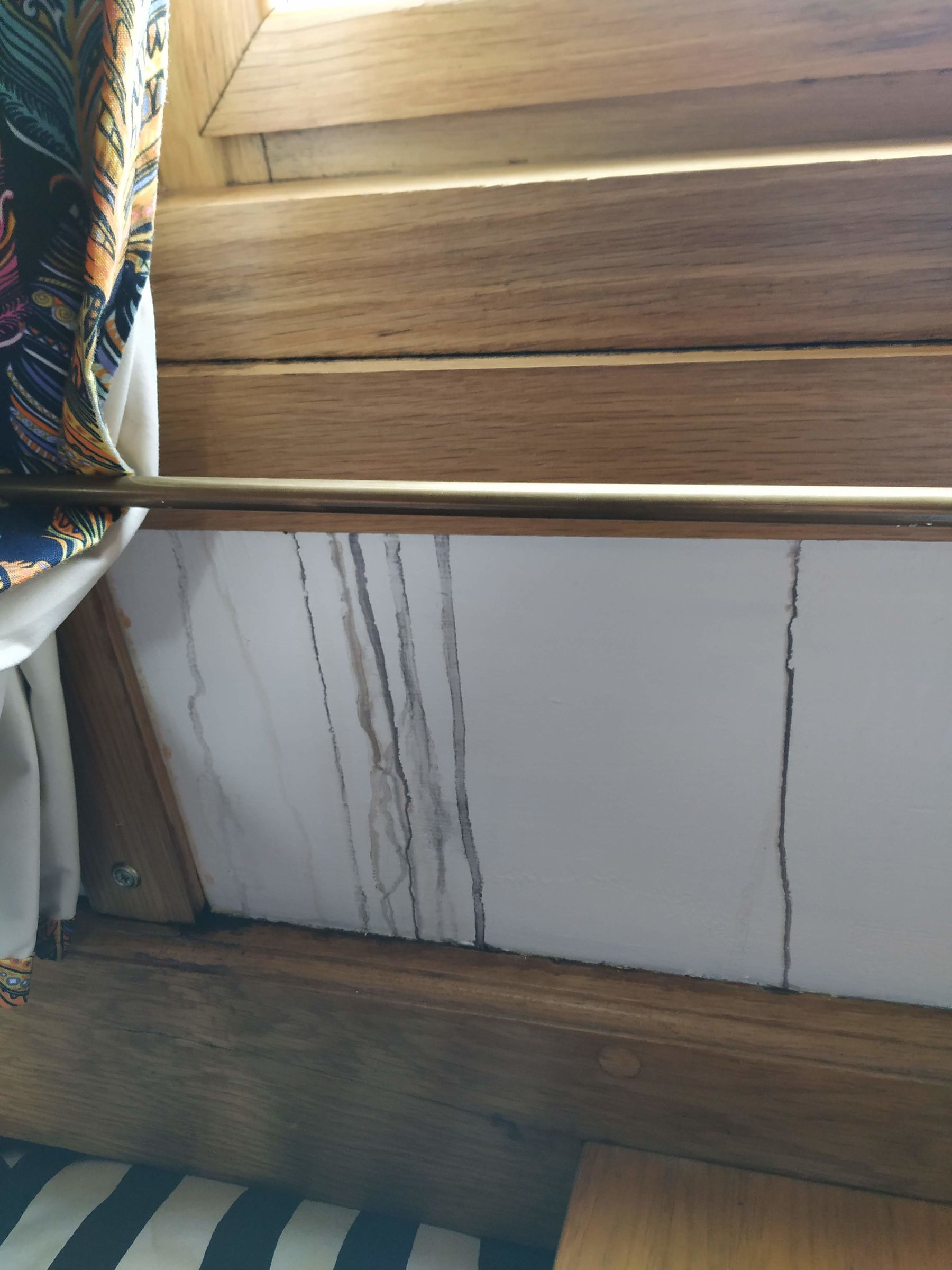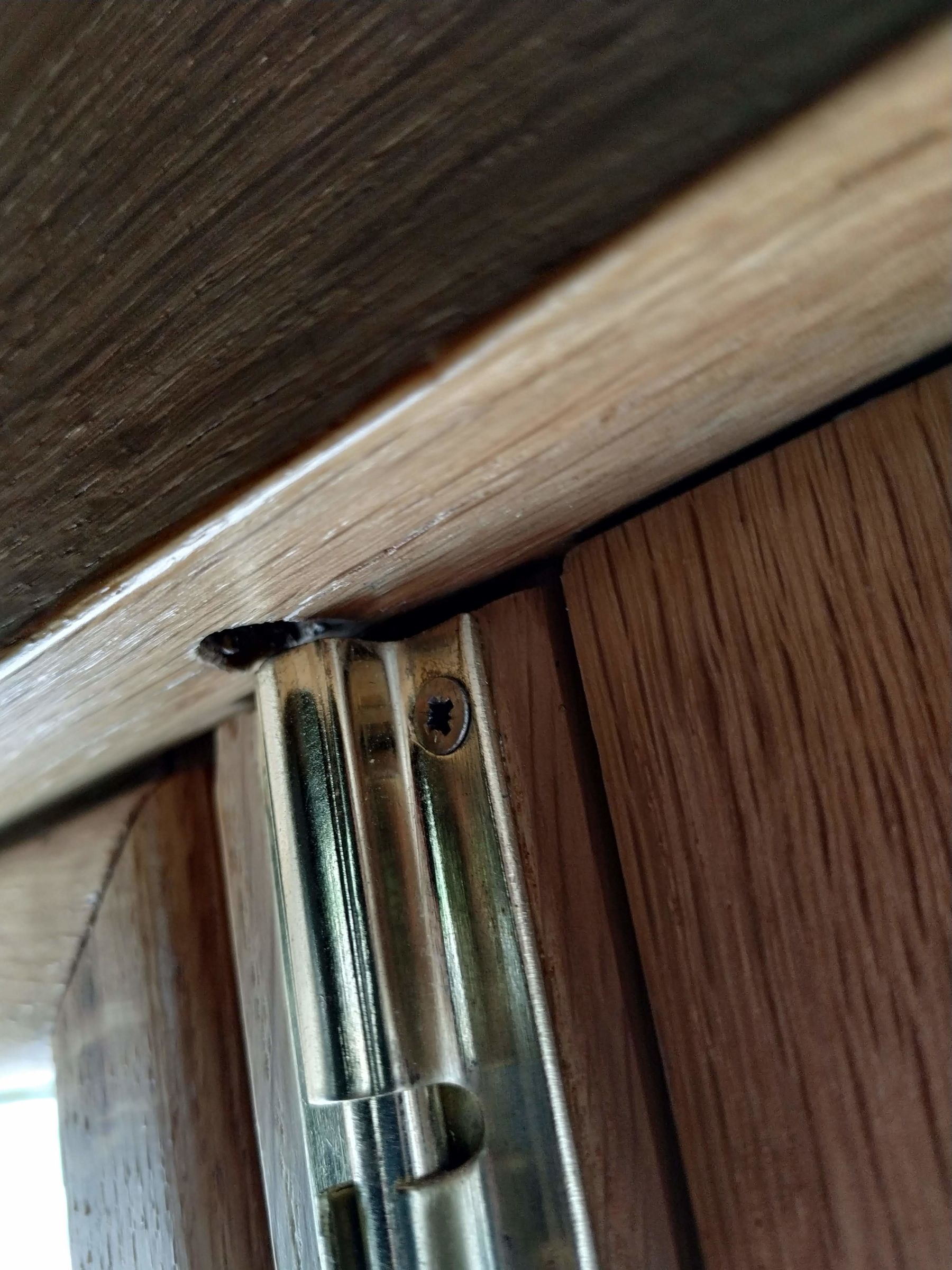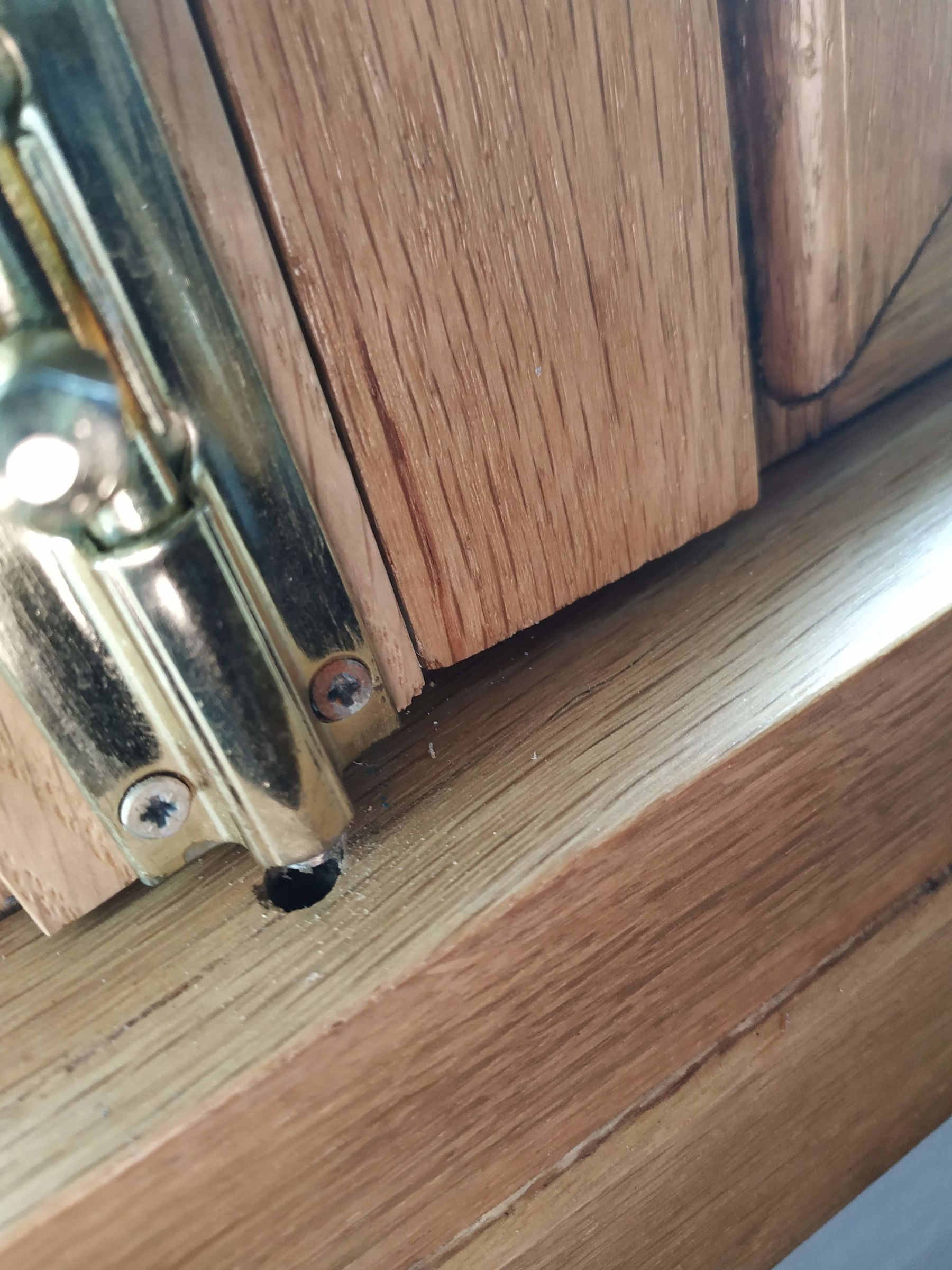

magictime
Member-
Posts
1,832 -
Joined
-
Last visited
-
Days Won
5
Content Type
Profiles
Forums
Events
Gallery
Blogs
Store
Everything posted by magictime
-

Kedian side hatches/doors 1 yr on (not impressed)
magictime replied to magictime's topic in General Boating
Sorry, I must have missed at least one email alerting me to new comments. The whole job was done by Martin - measuring up, manufacture of hatches, fitting which I'm sure included adding some insulation, wood lining. The steel was supplied with a coat of gloss and professionally painted within a few months when the rest of the boat was painted; the woodwork had three coats of exterior varnish added by ourselves very shortly after fitting. I might take some more pics tomorrow if people would find that useful. Someone (MtB?) made mention of the strange size and shape of the hatches; that's because they're designed to fit an existing window opening (they replaced two normal windows). I use 'hatch' rather than 'door' for just that reason, oddly enough! I think Martin calls them 'side doors'. -

Kedian side hatches/doors 1 yr on (not impressed)
magictime replied to magictime's topic in General Boating
It's a perfectly fair point. All I can say is what I said above, which is that it took some time to be sure there was a recurring problem and what the source of that problem was. I guess a bit of inertia crept in as well if I'm honest - 'oh we really should say something about this', then you go weeks without noticing the problem and the urgency evaporates. If a future customer learns from our experience, flags up a problem more quickly, and gets Martin to address it as a result, that's fine by me. Yeah this is part of the reason I talk about being unsure initially about the source of the problem, because we had new windows fitted last year too and thought potentially (some of) the water might (sometimes) have been coming from there. The visible water staining under the side hatch is what really clinched it and that didn't appear for some time. -

Kedian side hatches/doors 1 yr on (not impressed)
magictime replied to magictime's topic in General Boating
Separate steel frame, and I think the leak must be around the edge because I think the water is coming through internally, if you see what I mean. Time will tell whether you're right about the other doors; hopefully that's all it is, but then I'd have expected Martin to make the same diagnosis. I'll take a look, thanks. -
Martin Kedian fitted two of his glazed side hatches for us last year (January and April). At the time I posted on here saying how pleased I was with them, so I think I should really correct the record. One of them leaks in heavy rain; we first thought there might be an issue as early as last spring (water was appearing below the side hatch under the level of the gunwales), but during the drier months of the year it was hard to be sure there was a genuine pattern and that the side hatch was the source of the water. After a full winter it's clear what the problem is. (Pic is of the most visible signs; most of the water, as I say, drips out below gunwale level.) The other is now impossible to shut securely without pushing the doors in from outside; if you don't do this, the bolts and holes don't line up (see pics). Whether the steel frame or hinges have flexed somehow, or the wood has warped, or what, I don't know. Now hopefully this issue will be easy enough to 'bodge' with adjustments to the holes or bolts (or both), but presumably that would still leave a gap that shouldn't be there when the doors are shut, which doesn't inspire much confidence especially when we've had the issues with water-tightness of the other hatch. I contacted Martin this week and his response was simply that he can't offer 'an endless warranty'. (The second hatch was fitted just under twelve months ago, the first only three months before that.) So as nice as these things are in theory, I could not honestly recommend them as being fit for purpose. And to anyone considering getting Martin to do other work for them, I would suggest you at least get clear beforehand on whether he's prepared to vouch for it in the medium to long term. I know he has a good reputation on here for various jobs including overplating and boat lengthening, but he does seem to have very different ideas from me about what lifespan you can reasonably expect from an expensive, permanent alteration to a boat before it needs repair (and about the sort of aftercare you might expect after spending that sort of money). Other people might have had a different experience, or might think I've got unreasonable expectations, and that's fine; this is just my experience, and my thoughts, a year after having these side hatches fitted, and as I say, it's intended to 'correct' my earlier positive comment more than anything.
-
Okay, I'll give them a ring before making any assumptions!
-
Thanks. Another boater here in Long Eaton assured me Dobson's didn't have one!
-
No CRT services at Shardlow as far as I can see, but is there a practical private option? E.g. are the facilities at Shardlow Marina accessible on foot with a cassette on a trolley, and available to the public (for a charge)?
-
As I understand it, all visitor moorings that are normally restricted (to 48 hours or whatever) default to 14 days during stoppage season unless there's a sign specifically saying '48 hours all year round' or similar. So I think the answer is 'all areas'.
-
This post cannot be displayed because it is in a forum which requires at least 10 posts to view.
-
This post cannot be displayed because it is in a forum which requires at least 10 posts to view.
-
This post cannot be displayed because it is in a forum which requires at least 10 posts to view.
-
Congratulations! We've been living aboard just over a year and no regrets.
-
I could have lived with that side of it actually - maybe because we got used to finding a petrol station on foot and filling two 5 litre cans every day when cruising on our old petrol outboard boat! 5 litres once a week would have been okay (enough to run a small generator for say 12 hours). Still, combined with refuelling, storing/operating/servicing gennie etc it's a hassle I can certainly do without.
-
How long are you talking about being away from shore power, and how often? If you're talking about a few weeks a year, just run the engine. If months on end, and without solar power, the case for a generator makes more sense. I was weighing this up myself recently (year-round liveaboard CCer) and had pretty much talked myself into getting a generator, as I didn't want to be running my engine 20 hours a week or more through the winter (= say 6 days at 2 hours and one at 8 hours) even if staying put in a given week. But the practicalities and safety concerns regarding use and storage did worry me. In the end I've gone for a somewhat lateral solution; since my batteries need replacing anyway, I've bought a set of Pure Lead Carbon batteries that are claimed to charge faster and to be less reliant on frequent full charges to stay in good condition. Hence, in theory, I should be able to get by with maybe half the engine running time while stationary (say 60-90 minutes 7 days a week, which I'd need for hot water anyway), with full charges from a cruising day at least once a fortnight. They're expensive, but no more expensive than a regular set of batteries plus a generator plus fuel to run it. Made sense to me anyway; I'll see how they work out in practice.
-
We never knew our boat was a (sort of) ex hire till we found an old blog by the first owner. They had it built for themselves, but put it into a hire fleet for a couple of seasons while making preparations to move on board. So we bought a (sort of) ex hire boat without knowing it! Personally I'm inclined to think the regular maintenance, repaints etc. weigh more in ex hire boats' favour, than the risk of their possibly 'hard life' bumping in to things weighs against them. Many hire boaters are regulars and good at boat handling, many private boat owners will have had bumps over the years from awkward manoeuvres, accidents, high winds or whatnot. Most such bumps do no harm anyway. And in many ways I'd rather know that if any damage has occurred in the past, it's been assessed and dealt with by a hire firm rather than a private owner with who knows what level of expertise or DIY skills. Having said all that, we didn't (intentionally!) bother viewing any ex-hire boats when shopping around for our liveaboard because the layouts always seem to be based around cramming in extra berths and often extra toilets and showers. At the end of the day they're designed to be used generally by 4-8 people for short periods from spring to autumn, with most of every day spent on deck or in the pub - not by 1-2 people living on board all year.
-
The basic problem I've got with his reasoning comes out here: However, reducing this battery bank by 50% (to a single 100Ahr battery) would perhaps only reduce the life of the bank as a whole by say 30% because the single battery would still be being relatively well treated. So in this case a saving could have been made by buying half as many batteries (so half the initial outlay) and getting a battery life of 70%. A saving of 30% in monetary terms. Yes, you'll save money in the long term if you buy a new 100Ah bank every time your old one hits 80% capacity/end of life, rather than buying a new 200Ah battery bank every time your old one hits 80% capacity/end of life. That's what the illustration establishes. But if your cut-off point for your batteries needing replacement is that their capacity has dropped to 80Ah, why the hell would you buy a new 200Ah bank every time your old one hits 160Ah? It just makes no sense.
-
Well I don't know how else to interpret the statements: the most economical use of deep cycle batteries comes about when they are, on average, discharged to 50% capacity then recharged. Discharging deep cycle batteries to 50% results in the most economical use of the batteries in terms of battery life and monetary outlay. Yes, I didn't know what to make of this. (For a start, that's a saving of 33%, not 50% - one larger battery bank costing say £400 lasting as long as three smaller battery banks costing £200 each.) I wasn't sure what depths of discharge we were supposed to be talking about in this illustration: is the double-sized, 400Ah bank supposed to end up at a 50% DoD after drawing 100A for an hour? If not, how does it illustrate the 50% rule? Why should we think it's not more economical to add 50% to the capacity, or 150%, rather than 100%? This is partly why I've stuck to the clearer (to me) illustration of a 200Ah bank vs a 100Ah bank with the same 40Ah taken out of each.
-
Yes, but a rough rule of thumb should be at least roughly correct! As I've said, it feels to me as if we're talking about two quite different rules here: one, try not to discharge your batteries below 50% if you want to get reasonable value/a reasonable lifespan out of them (which seems fair enough); and two, the most economical way to buy and use batteries is to aim for a 50% depth of discharge in each cycle (which for the reasons I've set out, seems to me to be possibly based on a misapplication of the technical definition of 'end of life'). Phew!
-
I'm inclined to agree, obviously. But in that case the illustration doesn't support his '50% rule'. It shows that if you compare a 100Ah battery bank to a double-the-cost, double-the-size 200Ah battery bank, the latter will not take double the time to hit 80% of capacity, if both are used to supply 40Ah of charge before recharging. OK, fine. But that simply does not mean that the smaller bank is the more economical choice for someone requiring that 40Ah of useable capacity. It completely overlooks the fact that the bigger bank will still have 160Ah capacity remaining at 'end of life', and as such is surely likely to last at least as long again, and probably longer, before finally hitting the same 80Ah cut-off point for replacement as the smaller bank.
-
I'm not in a position to do that, obviously. But I am in a position to question whether his own illustrative example (the 100Ah bank lasting 70% as long as a 200Ah bank, if repeatedly discharged slowly by 40Ah and then recharged to 100%), actually supports the '50% rule' he's talking about. It doesn't, if he's taking 80% of original capacity to be the criterion for a battery bank's 'end of life'. If, on the other hand, he's talking about the end of a battery bank's useful life to a person requiring that useable capacity - 40Ah - the illustration supports the 50% rule only if the following is correct: a 200Ah battery bank charged and discharged in a 100%-80%-100% pattern will lose capacity far faster than a 100Ah bank charged and discharged in a 100%-60%-100% pattern. Specifically, it will take just about 40% longer for its capacity to drop by 60%/120Ah to 80Ah, than the smaller bank takes for its capacity to drop by 20%/20Ah to 80Ah. Which doesn't look remotely plausible, surely? In fact, since it's being discharged less deeply, it should lose capacity a lot more slowly... ...which is why I think he must be using '80% = end of life', since that fits the illustration in which the bigger bank 'lives' about 40% longer than the smaller (= the smaller bank has 70% of the lifespan of the bigger).
-
I'm not sure where the '300 cycles to death' thing is coming from (sorry), but I think you have in mind the heavy charge/heavy discharge example in that SG article? I was ignoring that one and going by the other one, where the shorter lifespan of the smaller battery presumably is due to sulphation from deeper discharge. Probably very wise if I've been on the right track with my thoughts on that Smartgauge article, but somebody clearly thinks there's such a rule, because that article is explicitly about a 50% rule relating to the most economical use of batteries.
-
It looks to me as if there are actually two different rules which can easily get confused because they have the '50% discharge' bit in common. One is a rule of thumb about the state of charge below which you shouldn't generally go if you want to get a decent lifespan out of your batteries; the other is alleged to be a more 'scientific' rule about the most economical pattern of cycling. I think you and I disagree about which one looks fair enough, and which one looks plain wrong!
-
Yes, but as I say, even if you make some pretty extreme assumptions about how quickly that larger bank deteriorates once it gets below 80% of capacity, I don't see how it could ever be the case that the smaller bank should be the most economical choice. Yes there's the question of what you can afford and what you have room for, but if we're talking about identifying the most economical choice in an ideal world as a starting point, I don't see how SG's '50% rule' could ever point you in the right direction.




